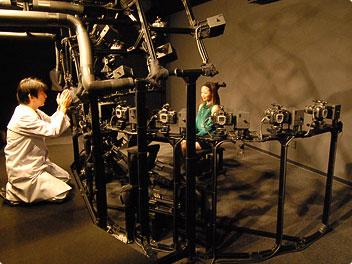Enabling the goal-oriented development of materials
Are other manufacturers engaged in the same type of project?

Although it is possible that other manufacturers are optimizing parts of the development process, I believe that this is the first attempt to do so in a comprehensive fashion. In general, manufacturers initially develop products using ordinary materials. In Japan, there are only a few cosmetics manufacturers like Kao who manufacture their own materials. The technology used in this foundation represents a unique effort—from material design onwards. The combination of a thin film and an intermediate layer has unlimited possibilities. It would probably have been impossible to realize this using the traditional trial-and-error method.
If you start with existing materials, you are constrained by their strengths and weaknesses throughout the entire process. If a key material is not available on the market, we are forced to make it ourselves. However, I would not want to go through a repeated trial-and-error process at that stage. Since we have an image of our ideal, it is better to work toward creating that ideal from the start.
Our goal is to make good products in the limited time available. In my own field, powder technology, it is said that powders are the devil's playthings, and that you never know what a powder will do until you test it. The philosophy was to engage in trial and error, experiment repeatedly, and wait for good results to emerge. Although this may work in some environments, technology is advancing, nanotechnology is being applied effectively, and the speeds of digital image processing and simulation are increasing. Our current efforts are rooted in the notion that we should combine these technological innovations. As such, from the outset, our goal has been to change the development process for cosmetics.
Finally, what are you considering doing next?

The control consoles for the multi-angle image capturing system. The controller for the lighting equipment is on the right.
So far, we have been using multi-angle images to see how color and luster change when the light source and perspective are changed. We are now thinking that we could use the multi-angle image capturing system for problem solving, for example, to investigate what the best products for disguising pores would be, or for improving makeup technology. Currently, there are various areas under consideration, including those that have nothing to do with development, and if we can clarify the problem areas, the ultimate objective should become clear. It should then be easy to incorporate these discoveries in the product development process.
Changing the lights and installing filters, enabling research to be conducted under various different lighting conditions, is also a possibility. However, this would be undertaken after the objective had been determined. This means investigating customer requirements and determining product concept. Up until now, the way in which the customer has been approached has also been rather unclear. However, from now on, we will be able to offer the customer objective suggestions, using photographs taken from multiple angles. Furthermore, in test monitoring of users, showing them photographs and listening to them would seem to make it psychologically easier to ascertain their requirements.
Since structural color is an extremely interesting field, there is a constant temptation to try and manufacture something new. However, the technical obstacles are considerable. In the development of cosmetics, only materials that have been verified as safe may be used. Thus, we cannot simply adopt new materials, no matter how good their color development properties are. In the case of structural color, however, we can simply use a combination of raw materials that is known not to be harmful to the skin or the thickness of the thin film to freely control color development. In this regard too, research into structural color will continue to attract interest.
Posted March 2008

